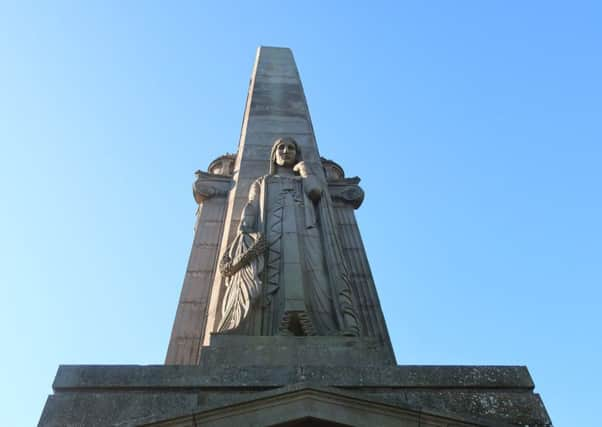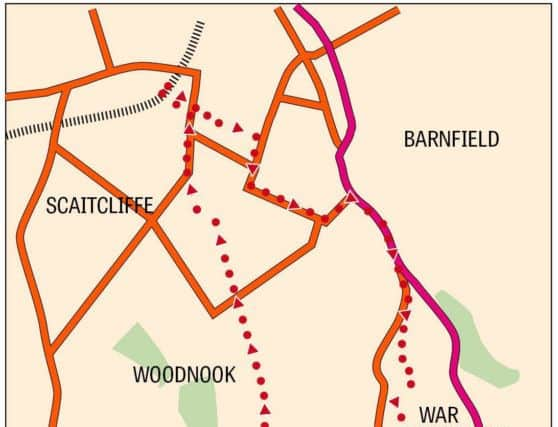Weekend walk


Four years ago the Lancashire Dotcom Walkers were witness to a moving ceremony. We had gathered at Oak Hill Park Accrington because November 11 had fallen on a Tuesday and we felt a strong need to mark the 100th Anniversary of World War One. We had no idea if anything was planned by way of commemoration but as we stood there a small party arrived. One was a bandsman who took station on the steps of the war memorial. Another I later found out was a retired vicar Kevin Logan. After a moment the Rev Logan asked for our attention and then conducted a brief and dignified service. His timing was impeccable for as he finished his opening remarks we heard the sound of a distant cannon signalling the start of two minutes silence. The bandsman then played “The Last Post” and Kevin read the time honoured extract from Laurence Binyon’s poem “For the Fallen”. “They shall not grow old as we that are left grow old.” We finished with a prayer and the National Anthem.
It was nicely done. It was fitting. Especially at the base of a monument dedicated to the Accrington Pals. “Pals” battalions were a creation particularly linked to the British Army in World War One. Reluctant to conscript (that is force) young men to join the army Lord Kitchener started a recruitment drive made famous by its iconic poster “Your Country Needs You” in which it was understood that friends, neighbours and work colleagues who enlisted together would stay together in platoons, companies and battalions.
Advertisement
Hide AdAdvertisement
Hide AdThis programme was particularly successful in the north of England and in of all the 50 towns that had “Pals” battalions the name of the Accrington Pals seems to have a particular resonance. In part it is because of Peter Whelan’s play of the same title. But more than anything it is because what occurred on July 1, 1916. This was the first day of the Battle of the Somme. The 11th Battalion East Lancashire Regiment was under orders to capture a village called Serre. As the Accrington Pals emerged from their lines they were met with withering machine gun fire. It was a this instance the great flaw in recruitment drive became obvious - neighbours and workmates who joined up in great numbers died in great numbers. In 20 murderous minutes, of the 700 men taking part in the attack 235 were killed and 350 were wounded. The effect on the town – at that time the smallest county borough in the country – was devastating. There was hardly a family unaffected by the loss of a father or son or brother.


So this short walk is for Remembrance, taking you to the war memorial dedicated to the young men of Accrington who died in both world wars.
“At the going down of the sun and in the morning we will remember them.”
WALK FACTS
Start: Accrington Railway
Station BB5 1QH
Distance: 2 ½ miles
Time: 1-1 ½ hours
Grade: Easy walking paved roads, parkland and cycleway
Map: OS Explorer 287 West Pennine Moors
Directions
1.From the railway station café with Tesco’s to the right cross the car park area to reach Eagle Street opposite a handsome Victorian building, once a bank. Keep ahead into Cannon Street. After crossing St James’ Street pass St James’ CofE Church to reach Church Street. Turn right towards the NHS building on the corner of Paradise Street seemingly dedicated to the Accrington Pals (though Pals in this context stands for Patient Advice and Liaison Service). Follow Church Street as it bends left and becomes Wellington Street. Keep on Wellington Street for 250yds to arrive at the former police station, a solid looking building on the right. At its corner turn right onto the A680 Manchester Road. Walk uphill for 300yds to the entrance of Oak Hill.
Advertisement
Hide AdAdvertisement
Hide Ad2. Not far from the entrance there is a helpful map. This shows that the war memorial is located near the western side of the park close to the tennis courts and bowling green and can be reached on the red route, though I found the approach from the pond and bandstand on the amber route gave more of a sense of the monumental scale of the structure. It is a huge obelisk fronted by a female figure head bowed in mourning. At the base are 20 panels each with the names of the war dead arranged in alphabetical order. There is an additional low wall with the names of the war dead of World War Two. All in all it is a sombre place.
3. To continue the walk exit from the park near the bowling green and turn left into Hollins Lane. The route continues for ¼ mile to Haworth Park. If time allows check out the park and the art gallery which has the largest collection of Tiffany glassware in Europe. On Hollins Lane look out for red metal posts on the right. Immediately beyond these turn right through a ginnel to come out onto leafy Royds Avenue. Turn right and then a short distance along turn left onto a broad track leading the edge of King George V Playing Fields. Keep ahead on a path that slopes down past the fields and after a wooden gate reaches a bridge across what was once a railway and is now the Hyndburn Greenway cycle route. Take a flight of steps to the left down to the cycle path and then turn right for the town centre.
- Bob’s walks are now available as digital guides on the iFootpath website and App (see iFootpath.com).